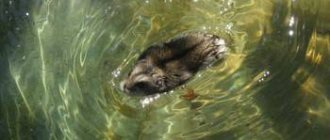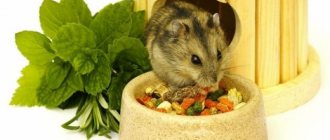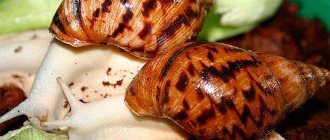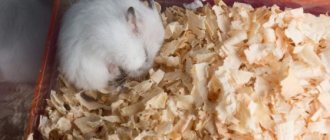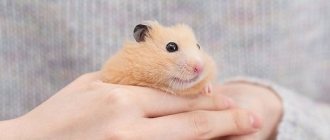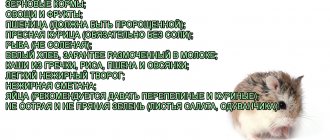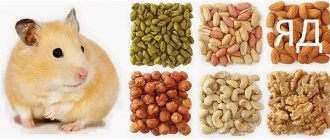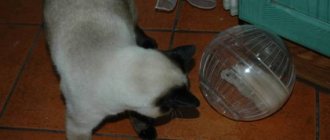/ Hamsters / The main differences between the Djungarian hamster and the Syrian
0
2939
Article rating
One of the most popular pets in our apartments are hamsters. Caring for little fluffies does not require much effort, but they bring joy and tenderness to their owners, both adults and children. There are two common breeds of these rodents in our country. What are the differences between the Djungarian hamster and the Syrian?
Differences between the Djungarian hamster and the Syrian
Content
The small size of these two species does not require a huge space; a small home is enough for them, basically a cage or glass terrarium. These breeds do not require a mandatory neighborhood and live well alone. Sawdust should be poured onto the floor of the cage.
The main diet is food of plant origin: grain feed, seeds, corn.
In the wild, animals dig deep burrows, with several entrances and corridors. The animals divide the house into burrows - for rest or “pantry”.
The mating season lasts a long time from March to October; at home, rodents can produce offspring all year round . On average, during one birth, a female produces 11 individuals.
But their pregnancies are different: Campbells carry babies from 18 to 22 days, and Djungarian mothers carry babies longer from 21 to 26 days.
Main differences
Despite many similar features, the main differences are highlighted:
Wool
The Djungarian hamster has dense fur, it is quite smooth and shiny. Campbells have a wavy coat and appear a little shaggy in appearance.
Color
Campbell's main shades:
- orange (mandarin)
- pearl
- sapphire.
Often, hamsters are red in color, have a uniform color, and have a dark stripe on the back.
A rare shade found in this species is agouti; even more rare are albino, argent, opal, gray, blue, spotted. The fur is somewhat disheveled.
Djungarians can come in a wide variety of colors, but their distinctive feature is stripes on the sides, on the back and a diamond on the face. The coat lies tightly and smooth.
Another important point is that in the cold season, Campbells have a change in coat color, and the Djungarian hamster may have a change in the stripe on its back, completely matching the main shade.
Anatomical differences
Dzungariks have an oval carcass that looks like an oval. Campbells externally repeat the outline of the number 8, due to the presence of a waist. The Djungarian rodent never has red eyes, while others do, but quite rarely. The Djungarian hamster has larger ears than the Campbell's.
Behavior
Many people like Djungarian hamsters and often get them: thanks to their friendliness, they are easily tamed and easy to get along with.
Campbell's rodent, on the contrary, is aggressive, and it is almost impossible to tame it. Both breeds are quite active animals; they love to run in a wheel, bury themselves in sawdust and create order in the bowl, creating noise.
External characteristics
If you place two types of hamsters next to each other, the differences will be obvious. Djungarians look like small fluffy mice without tails , gray or light - depending on the time of year. Syrians are larger, most often have a golden-red color , which does not change in winter.
Djungarians are very small and quite independent
Dzungarian breed
Djungarians are small - the length together with the tiny tail reaches 10 cm, the weight is also small - a large male weighs a maximum of 50 grams.
- The most common breeds are gray-brown in color, with a slight reddish-gold tint and always have a stripe on the back. The fur is not very long; in healthy animals it is smooth and shiny.
- By winter, the dwarfs change color - they become very light, almost white, and the stripe on the back almost disappears - it becomes weakly expressed.
Some babies change color only partially - the fur becomes light gray, almost white, but gray spots remain, and the stripe on the back remains bright.
Syrians come in several colors
Syrian breed
The largest Syrian hamster can grow up to 20 cm; such a rodent weighs 150 grams.
Reference. Syrians are called “golden” for their color - reddish or peach, differing in shades.
There are Syrians and other, more exotic colors:
- black (such hamsters are called little bear cubs);
- white - with red eyes;
- silver-gray - with a slight bluish tint;
- light peach;
- bright copper.
Over many years of breeding Syrians, many breeds with different lengths of hair have been developed - from very short to long, like Angora rabbits.
How to care for a Syrian hamster?
Conclusion
The above signs will help you easily distinguish between breeds. If the animal does not match the basic traits, this indicates crossbreeding, which is undesirable for these breeds, as it can cause mutations in subsequent generations. But crossing allows you to achieve unique, rather interesting shades of wool.
It is important to remember that, unfortunately, both breeds have a rather short life expectancy - only three years, but proper maintenance and care will give you a pet that will delight you and give you pleasant emotions.
Syrian hamsters
Syrian hamsters can rightfully be considered one of the most popular and famous domestic small rodents. Hamsters of this type are very easy to keep at home, even for those who have never had any animals or who do not have much time to spend with pets, because these rodents are simple and cheap to keep. Even the smallest child can take care of them.
Syrian hamsters originated in Central and South Asia. They became widely known and widespread in the twentieth century. These animals are practically never found in the wild and are, as a rule, exclusively domestic animals. Previously, they were also used by scientists to conduct all kinds of medical experiments. By the way, these rodents are also often called golden because of their golden fur.
The behavior of Syrian hamsters is almost entirely reminiscent of the habits of such animals of other breeds. This is a nocturnal and very active animal that can immediately run a distance of several kilometers. But during the daytime, rodents mostly sleep. They prefer to live alone in small burrows. These small animals come together only during the mating season. In other cases, they do not like to be around their fellow tribesmen.
Now hamsters of this type are almost never found in the wild and are listed in the Red Book.
Currently, wild Syrian hamsters can only be seen occasionally in Turkey and Syria. These animals are very popular among people from all over the world, who prefer to keep them at home. Their approximate lifespan in captivity with quality care is three to four years.
Breed characteristics
Syrian hamsters weigh 100–200 grams and have a body length of 13–19 centimeters. Males are larger than females. Animals have special pouches behind their cheeks that have noticeable capacity and are designed for carrying food or materials into their burrow.
Typically, such rodents live in a house for about 2.5 years, but in ideal conditions they can live up to four years. But science knows the facts of real hamster longevity. Some of these animals were able to live up to seven years.
Animals are very active and restless. They are incredibly tenacious and constantly on the move. The front paws of hamsters have four toes and a vestige of a fifth. They hold food with them. They have five toes on their hind legs. With them they easily cling to the bars of their cages and can hang in this position for quite a long time.
The animals have a small elongated muzzle with black eyes and small ears, as well as a small and funny sticking tail.
Where does it live and what does it eat?
Unlike the Djungarian hamster, the range of this animal is quite limited: it is found in Syrian, Turkish and Israeli semi-deserts. Due to human activities and the species' status as a pest, the Syrian hamster's habitat is in constant decline, and the species is now listed as endangered according to the International Union for Conservation of Nature (IUCN).
Like other hamsters, this one is most active at dusk or dawn. The Syrian is quite mobile: observations by zoologists have shown that during the “night shift” this animal is capable of running from three to eight kilometers. When clarifying which is better - the Djungarian or Syrian hamster - keep in mind that the Syrian is more active, and often this activity manifests itself in the evening, when he begins to run around on the wheel and explore his home in every possible way.
The life expectancy of the Syrian hamster is short, it is the same as that of the Djungarian hamster. This circumstance greatly upsets those who want to have this pet, who are thinking about which is better - a Syrian or a Djungarian hamster.
The diet of the Syrian is much wider: this animal is considered a practically omnivorous rodent, because it is able to feed not only on cereal seeds and all types of nuts (which, by the way, are prohibited for Djungarian hamsters), but also on small insects. Of the nuts, however, almonds and fruit seeds are contraindicated for Syrians.
Interesting facts about golden hamsters
Animals of this breed living in captivity are very friendly and not at all aggressive. This is what distinguishes them from their wild counterparts. But at the same time, they skillfully guard their territory and will not allow strangers to be on it. For them there is no concept of family ties. These animals prefer to live alone and are capable of killing a weaker hamster. Therefore, owners should keep them alone.
Scientists have proven that Syrian hamsters can eat almost anything. Therefore, in addition to seeds and grains or fruits, they also need to eat animal protein. In the wild, they can eat insects, carrion, or even hunt other small animals. In addition, sometimes females can destroy their offspring, which their owners try to prevent in captivity.
At home, these animals should be given lean and thoroughly cooked poultry or fish. Otherwise, these small and usually calm animals become quite aggressive and can bite.
Djungarian hamsters
The Djungarian hamster is another famous domestic representative of the hamster family. It is characterized by a height of up to 10 centimeters and a weight of 35–65 grams. They are characterized by fur-covered feet, as well as a recognizable dark (usually gray) stripe on the back. These animals have almost no tail.
Their fur is very beautiful due to the presence of white hairs. Despite the fact that now small animals of this species are considered to be domestic, they can sometimes be found in the wild in semi-deserts or dry steppes, for example, in Khakassia, in the south of Western Siberia and in the Dzungarian Alatau. Hamsters usually live 2-3 years, but can sometimes live up to four years.
Coat types
Through the work of breeders, four separate subspecies of Syrian hamsters have been bred. These subspecies are distinguished by the following types of coat. The most common and common is the short-haired type. With such plush-like fur, different colors look best.
Long-haired Syrians have also been bred, another name for which is Angora. Males of this subspecies have a kind of “skirt” of long (8 to 10 cm) hair in the lower part of their body. However, the females look like ordinary Syrians, perhaps a little fluffier. In foreign pet stores, this variety is called “Teddy Bear hamster”.
The Satin or Satin Syrian hamster is distinguished by fur with a special, almost glossy sheen. This effect was achieved by breeding a new variety whose fur contained hollow hairs. However, individuals of Satin Syrians cannot be mated with each other, since this may result in the birth of animals with sparse hair or its complete absence.
Rex (or Curly) hamsters give the impression of being disheveled animals - the hairs in their lush outfit are slightly curled. In addition, rexes also have curled mustaches. This variety can be either short(-) or long-haired.
The last variety is represented by Hairless Syrian hamsters. They are characterized by a complete absence of hair. However, animals with such a fixed mutation sometimes still have a certain velvety appearance and even short “whiskers”.
Unfortunately, representatives of hairless Syrians are quite sickly, they require special care: in unfavorable temperature conditions, some owners even “dress” them. In addition, the life expectancy of a hairless Syrian hamster is half that of normal.
